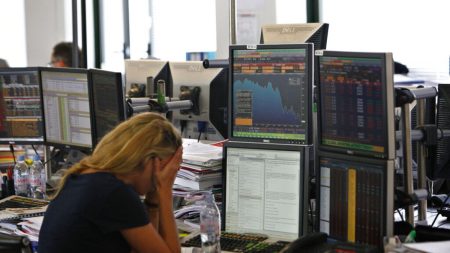China’s Faltering Retail Sales Cast a Shadow Over European Markets and Global Economic Outlook
The latest economic data from China has sent ripples of concern throughout global markets, revealing a slowdown in consumer spending and raising questions about the strength of the post-pandemic recovery. November’s retail sales figures, showing a mere 3% year-on-year growth, significantly missed economists’ projections of 5% and marked the slowest pace in three months. This disappointing performance follows a brief surge in October fueled by the Singles’ Day shopping extravaganza, suggesting that underlying consumer demand remains fragile despite government stimulus efforts. The news has cast a pall over Asian markets and is expected to weigh heavily on European trading, particularly in consumer-focused sectors, as investors grapple with the implications of a sluggish Chinese economy.
The weak retail sales data comes as a blow to hopes of a robust rebound in China, the world’s second-largest economy. Earlier in the week, European markets had responded positively to China’s commitment to implement proactive fiscal and moderately loose monetary policies in the coming year. However, this optimism has quickly evaporated in the face of the disappointing retail figures, coupled with lower-than-expected inflation and trade data. The fragile state of the Chinese consumer market has direct implications for European businesses, particularly in luxury goods, mining, and energy sectors, which are heavily reliant on Chinese demand. Shares of luxury giants like LVMH, Hermès, and Kering, which had initially rallied on the prospect of Chinese stimulus, have since given back their gains, reflecting the growing unease among investors.
The broader economic picture in China remains mixed. While industrial output maintained a steady 5.4% year-on-year growth in November, in line with October’s figures, fixed asset investment growth slowed slightly to 3.3% for the first 11 months of the year, compared to 3.4% in October. Trade data also painted a concerning picture, with exports growing by 6.7% and imports declining by 3.9% year-on-year, both figures falling short of market expectations. This weaker-than-anticipated trade performance further underscores the challenges facing the Chinese economy and suggests that global demand may be softening. The subdued consumer price index (CPI) of 0.2%, the slowest pace since June, reinforces the narrative of weak domestic demand.
Despite the prevailing gloom, there are some glimmers of hope. The decline in Chinese housing prices has moderated for the third consecutive month, with new-home sales prices falling by just 0.2% in November compared to the previous month. This marks the softest decrease in 17 months and suggests that government measures to support the property market, including record-low interest rates implemented by the People’s Bank of China in October, are beginning to have an impact. However, the overall recovery in the housing sector remains tentative, and its contribution to broader economic growth remains uncertain.
The disappointing economic data from China highlights the delicate balance facing policymakers as they attempt to navigate a complex economic landscape. The government’s commitment to proactive fiscal and monetary policies will be crucial in the coming months, as will the effective implementation of these policies. The ability of the Chinese economy to regain momentum will depend on a combination of factors, including the success of stimulus measures, the evolution of global demand, and the resilience of the domestic consumer.
Looking ahead, some analysts believe that China’s economy could rebound by 2025 if the government delivers on its promised stimulus measures. However, the path to recovery is likely to be uneven and fraught with challenges. The recent economic data serves as a stark reminder of the fragility of the global economic outlook and the interconnectedness of global markets. The performance of the Chinese economy will continue to be a key driver of global growth and market sentiment in the months and years to come. The world is watching closely to see whether China can reignite its economic engine and provide the much-needed boost to global demand.














